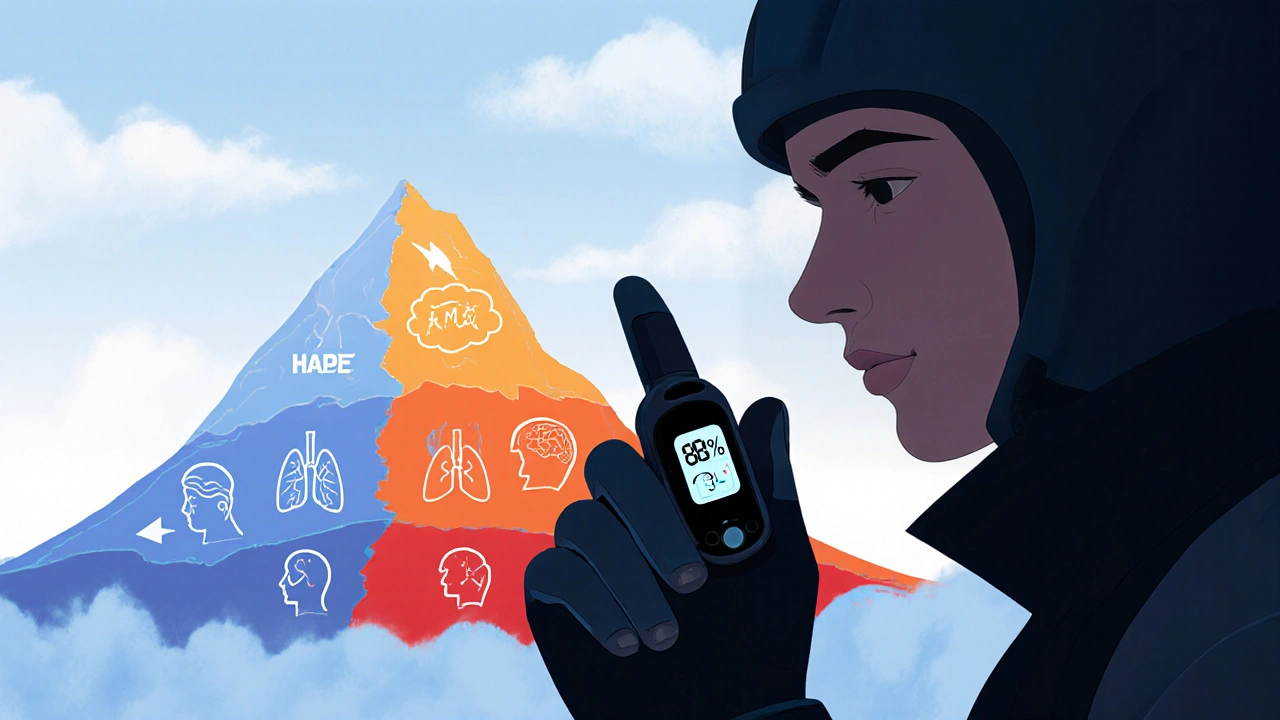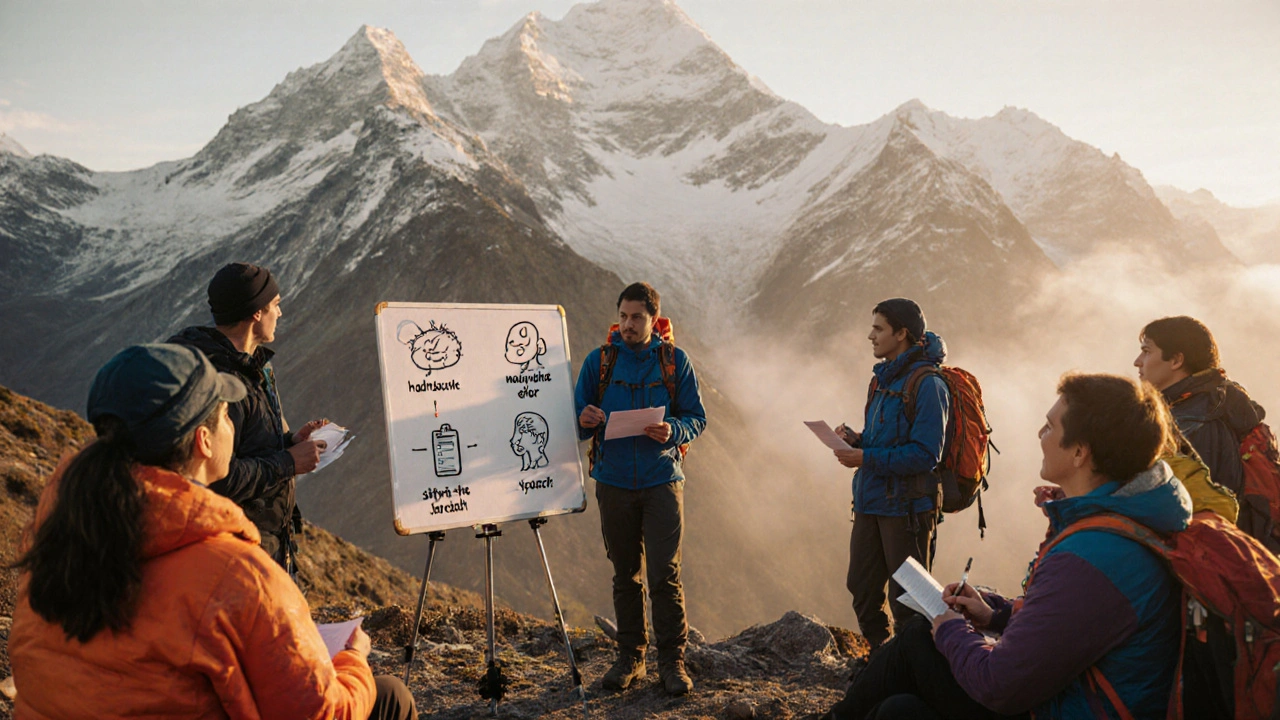Mountain Sickness Symptom Checker
Symptom Assessment
Select any symptoms you're experiencing:
Oxygen Saturation Monitor
Enter your current SpO₂ reading:
Symptom Guide
Acute Mountain Sickness (AMS)
Headache, nausea, dizziness. Usually occurs above 2,500m.
High-Altitude Pulmonary Edema (HAPE)
Shortness of breath at rest, coughing, chest tightness.
High-Altitude Cerebral Edema (HACE)
Confusion, loss of coordination, slurred speech.
Early Warning Signs
Persistent headache, rapid heartbeat, decreased oxygen saturation.
Assessment Results
TL;DR:
- Learn the core symptoms of mountain sickness early to act fast.
- Acclimatize slowly and use simple tools like a pulse oximeter.
- Education-whether briefings, apps, or signage-cuts severe cases by up to 60%.
- Community awareness campaigns keep critical info visible on trails.
- Follow a ready-to-use checklist before every high‑altitude trek.
Heading up a mountain feels awesome, but the thin air can turn excitement into a medical emergency in minutes. The real hero in those moments isn’t a fancy gadget; it’s knowledge. When hikers, guides, and park officials understand how altitude affects the body, they can stop mountain sickness a collection of altitude‑related illnesses that range from mild headaches to life‑threatening brain swelling before it spirals out of control. This guide shows why education and awareness are the backbone of any effective prevention strategy and gives you practical steps you can start using today.
What Exactly Is Mountain Sickness?
Most people think of altitude sickness as a single ailment, but it actually covers three main conditions. Acute Mountain Sickness (AMS) the mildest form, marked by headache, nausea, and dizziness that usually appears above 2,500m is the most common. If you ignore AMS, you risk escalating to High‑Altitude Pulmonary Edema (HAPE) fluid accumulation in the lungs that leads to breathlessness, coughing, and low oxygen saturation, or High‑Altitude Cerebral Edema (HACE) brain swelling that causes confusion, loss of coordination, and can be fatal if untreated. Knowing these distinctions helps you decide when a simple rest will do and when professional evacuation is required.
Why Education Beats Guesswork
If you think “just keep climbing until you feel fine,” you’re ignoring the body’s subtle warning signs. Studies from mountain rescue services in the Alps and the Himalayas show that groups who receive a 15‑minute pre‑trip briefing reduce severe AMS cases by roughly 55% compared with unguided trekkers. Education works because it turns abstract risk into concrete actions: checking oxygen levels, pacing ascent, and recognizing when to descend. It also builds confidence-people who know what to look for are less likely to panic when symptoms appear, which improves overall safety on the trail.
Spot the Symptoms Early
The faster you identify the problem, the easier it is to treat. Below is a quick symptom cheat‑sheet you can keep on a phone or printed card.
- Headache: persistent, pressure‑like, not relieved by painkillers.
- Nausea or loss of appetite: especially when combined with dizziness.
- Shortness of breath at rest: a red flag for HAPE.
- Confusion, slurred speech, or unsteady gait: immediate signs of HACE.
- Rapid heartbeat (tachycardia): indicates the heart is working harder to pump oxygen.
Pair these signs with a quick check of your portable pulse oximeter a handheld device that shows blood‑oxygen saturation (SpO₂) levels in real time. A reading below 90% at rest usually means you need to stop ascending and consider descending.

Best Ways to Teach and Share the Knowledge
Education comes in many formats, each with its own strengths. The table below compares the most popular channels used by rescue teams, guide services, and national parks.
| Method | Cost | Reach | Effectiveness (reported reduction in severe cases) |
|---|---|---|---|
| Pre‑trip Briefing (30min) | Low (staff time) | All registered hikers | ≈55% |
| Mobile App with Altitude Alerts | Medium (development) | Tech‑savvy users | ≈45% |
| Trail Signage & Posters | Low (printing) | On‑site hikers | ≈30% |
| Community Workshops | Variable (venue) | Local climbers & guides | ≈60% |
What works best for you depends on the group size, technology access, and the terrain you’re tackling. A blended approach-quick briefing plus a free app download-covers most bases without breaking the budget.
Acclimatization: The Science of Going Slow
Acclimatization isn’t a myth; it’s the body’s natural response to lower oxygen. During the first 24‑48hours at altitude, your breathing rate increases, and your red blood cells start producing more hemoglobin. By the end of a week, the body can improve oxygen transport by up to 30%.
Here are three evidence‑based tactics you can adopt on any trek:
- **Climb high, sleep low** - spend daytime at a higher camp but return to a lower altitude for sleep.
- **Add rest days** - schedule a full day of no ascent for every 300‑400m gained above 3,000m.
- **Stay hydrated and avoid alcohol** - dehydration thins the blood, making oxygen delivery harder.
When you combine these steps with regular symptom checks, the chance of progressing from AMS to HAPE or HACE drops dramatically.
Community Awareness Campaigns: Keeping the Message Alive
Education isn’t a one‑off event; it lives on the trail, in local shops, and on social media. A well‑run awareness campaign coordinated effort involving posters, talks, and digital outreach to spread altitude‑safety knowledge can reinforce what hikers learned during briefings.
Key ingredients of a successful campaign include:
- **Visual Storytelling** - infographics that show a simple “headache → check SpO₂ → rest or descend” flow.
- **Local Partnerships** - work with gear shops to hand out cheat‑sheets with every purchased jacket.
- **Social Proof** - share real rescue stories (with permission) to illustrate consequences.
When the message repeats across multiple touchpoints, it becomes second nature, and hikers are more likely to act before a problem escalates.
Pre‑Trip Checklist for Every Hiker
Use this short list to verify you’ve covered the basics before you start your ascent.
- Read a concise brief on AMS, HAPE, and HACE symptoms.
- Pack a pulse oximeter battery‑powered device that displays SpO₂ percentages and test it before departure.
- Plan an itinerary that includes a rest day every 300‑400m of elevation gain.
- Download a reliable altitude‑alert app and enable push notifications.
- Brief every travel companion on the symptom cheat‑sheet and emergency descent plan.
Cross‑checking these items takes under ten minutes but can save days of recovery-or a life.

Frequently Asked Questions
Can I prevent mountain sickness without medication?
Yes. Proper acclimatization, staying hydrated, and recognizing symptoms early are the most effective non‑pharmaceutical strategies. Over‑the‑counter drugs like acetazolamide can help, but they’re not a substitute for gradual ascent and education.
How accurate is a pulse oximeter at 4,000m?
Modern fingertip oximeters are reliable down to about 2,500m, and most still give useful trends up to 5,000m. A reading under 90% consistently signals you need to stop ascending and rest.
What’s the fastest way to learn the symptoms?
A 15‑minute pre‑trip briefing combined with a pocket cheat‑sheet or an app that pops up a reminder when altitude >2,500m gives the highest retention rates. Repetition on the trail solidifies memory.
Should I descend immediately if I get a headache?
A mild headache early on can be managed by resting and hydrating, but if it persists after an hour or worsens, start descending. The earlier you descend, the better the outcome.
Are group briefings more effective than individual ones?
Group briefings create a shared language for safety, so peers can watch each other’s symptoms. Data from the Swiss Alpine Club shows group briefings cut severe AMS incidents by 30% compared with solo hikers who only read pamphlets.


Bridget Jonesberg
October 3, 2025 AT 17:46Let's cut through the fluff and remember that altitude can mess with your brain chemistry faster than a caffeine binge, so the first rule is to keep tabs on your head and your breathing. A simple headache that won’t quit after a cup of water is your body waving a red flag. If nausea tags along, you’re flirting with Acute Mountain Sickness and should take a step back. The moment you feel short of breath while standing still, think HAPE and stop climbing right then. Confusion or a wobbly gait? That’s the gateway to High‑Altitude Cerebral Edema – a true emergency. Hydration isn’t just a suggestion, it’s a lifeline; dehydration amplifies hypoxia. Slow ascent is the golden ticket – climb high, sleep low, and insert rest days every few hundred meters. A pocket‑sized pulse oximeter can give you a quick SpO₂ reading, and anything below 90% screams descent. Remember, the mountain doesn’t care about your schedule; it respects the physics of oxygen. Education isn’t a one‑off lecture, it’s a habit you build before you strap on your boots. Shared checklists among group members turn the whole party into a safety net. Posters at trailheads, Instagram stories, and QR‑linked cheat‑sheets all reinforce the same message. If you ever feel the urge to push through a bad headache, you’re ignoring the three‑step rule: rest, hydrate, descend if needed. The most stubborn hikers are often the ones who get rescued later. So, respect the altitude, respect the signs, and you’ll keep the summit experience alive.
Marvin Powers
October 4, 2025 AT 02:06Oh, the joys of pretending you’re a mountain goat when you’re really just a glorified tourist – let’s talk about how a sprinkle of sarcasm can actually save your life up there. First off, if you think a “little headache” is just a souvenir, think again; it’s your body’s polite way of saying, “Hey, maybe chill on the ascent.” The classic “drink water” advice isn’t a myth, it’s your portable oxygen pump – dehydration makes you breathe like a wheezing dragon. A quick glance at your pulse‑oximeter is like checking the fuel gauge before a road trip; under 90% and you’re basically driving a car with no gasoline. You’ve probably heard the phrase “climb high, sleep low,” which, shockingly, isn’t just a catchy tagline but a science‑backed strategy to let your red blood cells catch up. When you’re at 3,500 m and still feel like a balloon, that’s the moment you either stop and enjoy the view or start a free‑fall rescue scenario. Group briefings are the secret sauce – they turn a lone wolf into a safety net, and they cut severe cases by more than half, according to the Alpine Rescue stats. The community posters you skip are actually visual nudges that work better than a lecture from a bored guide. Apps with altitude alerts can ping you before your brain decides to shut down; enable them and you’ll thank yourself later. Remember, the mountain doesn’t care about your ego; it only respects the physics of oxygen delivery. So, keep that cheeky optimism in check, listen to the symptoms, and you’ll avoid turning a weekend trek into an episode of “Survivor: Alpine Edition.”
Jaime Torres
October 4, 2025 AT 10:26Looks fine. Keep an eye on oxygen levels.
Kyle Olsen
October 4, 2025 AT 18:46It is of paramount importance to acknowledge the physiological ramifications of hypobaric environments, therefore, a methodical exposition shall be presented. The diminution of atmospheric pressure engenders a cascade of compensatory mechanisms, commencing with hyperventilation to augment alveolar oxygen diffusion. Concomitantly, erythropoiesis is stimulated, resulting in an elevated hemoglobin concentration over a period of days. Nevertheless, the immediacy of symptom onset in Acute Mountain Sickness obliges the practitioner to adopt a preemptive stance. A prodromal headache, persisting beyond the usual analgesic response, constitutes a sentinel event warranting cessation of ascent. Nausea, in the absence of dietary indiscretion, further reinforces the diagnostic inference. Should the climber manifest dyspnea at rest, one must infer the development of High‑Altitude Pulmonary Edema, necessitating immediate descent and supplemental oxygen. Neurological deficits, such as ataxia or dysarthria, unequivocally denote High‑Altitude Cerebral Edema, a life‑threatening condition demanding emergent evacuation. It is incumbent upon guides to disseminate this knowledge through structured briefings, thereby reducing incidence rates by a statistically significant margin. Empirical data from the International Alpine Association corroborate a reduction in severe cases exceeding fifty percent when comprehensive education is administered. Moreover, the utilization of portable pulse oximeters serves as an indispensable adjunct, offering quantifiable SpO₂ values that guide clinical decision‑making. A reading inferior to ninety percent at repose unequivocally signals the necessity for descent. In summation, the synthesis of acclimatization strategies, vigilant symptom monitoring, and technological aids constitutes the optimal paradigm for the prevention of altitude‑related pathology.
Lawrence Bergfeld
October 5, 2025 AT 03:06Great point, Kyle. To add, a concise checklist that includes checking SpO₂, reviewing symptoms, and confirming hydration status can be printed on a single card. This keeps the group aligned and speeds up decision‑making when time is critical. Also, remind everyone to re‑hydrate with electrolytes, not just plain water.
Chelsea Kerr
October 5, 2025 AT 11:26🚩 Knowledge is the ultimate safety gear. When you understand that a persistent headache isn’t just “tiredness,” you can act before the situation spirals. I’ve seen groups who skipped the briefings end up in rescue scenarios that could’ve been avoided. Sharing a simple infographic at the trailhead can make that difference – a visual cue that says, "Check your SpO₂, rest if it drops below 90%". 🌄
Tom Becker
October 5, 2025 AT 19:46Whats the point of all this safety crap? The government wants us scared so they can sell more gadgets. Just climb, feel the rush, and ignore the "danger" warnings. Who needs a pulse ox anyway?
Laura Sanders
October 6, 2025 AT 04:06Facts: the literature is clear that a structured pre‑trip briefing reduces severe altitude illness by over 50%. Ignoring that is simply negligence, not bravery.
Jai Patel
October 6, 2025 AT 12:26Hey, let’s spice it up! Imagine a vibrant poster with a cartoon mountain saying, "Don’t let a headache ruin your summit selfie! Check SpO₂, hydrate, and chill for a minute." Bright colors, catchy rhyme, and a QR code to a quick guide – that’s how you get people to actually remember the steps. Plus, a fun group chant during acclimatization days: "Breathe deep, climb slow, safety we’ll show!" Keeps morale high and the risk low.
Zara @WSLab
October 6, 2025 AT 20:46Really appreciate the thoroughness here – the blend of data, practical tips, and emphasis on community messaging makes a solid blueprint for safe trekking.
Randy Pierson
October 7, 2025 AT 05:06Indeed, the integration of technology, such as real‑time altitude alerts, with timeless practices like "climb high, sleep low" creates a robust safety net. The synergy between human vigilance and digital assistance cannot be overstated.
Bruce T
October 7, 2025 AT 13:26Honestly, if you’re not reading the signs, you’re just asking for trouble. The mountain isn’t a playground; it’s a serious environment that demands respect.
Darla Sudheer
October 7, 2025 AT 21:46You’re spot on. A quick reminder to the crew: keep your packs light, monitor your vitals, and never ignore a headache after a few hours at altitude.
Elizabeth González
October 8, 2025 AT 06:06From a philosophical standpoint, the mountain serves as a mirror reflecting our respect for natural limits; acknowledging its warnings is a form of humility.
chioma uche
October 8, 2025 AT 14:26We must protect our mountains from outsiders.